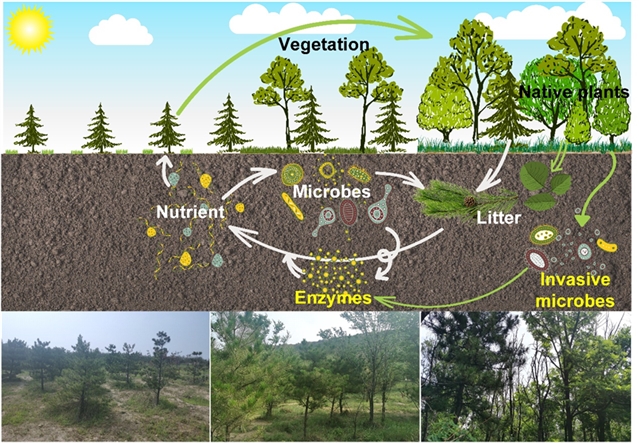|
|
|
|
|
SEL | 前沿研究:黄土高原土壤微生物介导的酶促进了采后复垦人工林的次生演替 |
|
|
论文标题:Soil microbes-mediated enzymes promoted the secondary succession in post-mining plantations on the Loess Plateau, China(黄土高原土壤微生物介导的酶促进了采后复垦人工林的次生演替)
期刊:Soil Ecology Letters
作者:Qi Zhang, Jing Ma, Alejandro Gonzalez-Ollauri, Yongjun Yang, Fu Chen
发表时间:30 Jun 2022
DOI:10.1007/s42832-022-0148-0
微信链接:点击此处阅读微信文章
本研究选取中国山西安太堡露天矿区排土场的三个不同演替阶段的人工林,通过植被调查和土壤性质及土壤微生物群落分析,探究不同次生演替类型下,植被-土壤-微生物系统的差异,以及土壤微生物群落及其胞外酶在矿山生态系统重建过程中的作用。结果表明,周边植被的入侵引发了排土场人工油松林次生演替的差异,改变了植被构型和土壤营养条件。土壤微生物通过释放脲酶和β葡萄糖苷酶等胞外酶增加了土壤有机质和硝态氮,促进了植被多样性和生物量的提升,推进了矿山排土场的生态恢复。
文章简介
露天煤矿开采需剥离表土,往往产生大面积裸露的排土场,因而不同的植被配置模式成为生态恢复的关键科学问题。同一植被配置模式经过30年恢复却显现出截然不同的恢复状态,探究植被恢复差异的成因及其演替机制对未来矿山生态修复至关重要。

本研究在山西省安太堡露天矿区已恢复了30年的排土场中,选取了3个初始立地条件和恢复措施相似,处于不同次生演替进程的人工油松林,调查了土壤理化性质、酶活性、植被和微生物群落特征,并通过建立结构方程模型探索植物、土壤和微生物之间的相互关系,分析土壤微生物及其胞外酶在矿山排土场生态恢复过程中的作用。结果表明,次生演替造成不同人工油松林植被构型和土壤营养条件的显著差异,随着次生演替过程的推进,植物盖度由34.8%增加到95.5%,土壤有机质由9.30 g·kg-1增加到21.13 g·kg-1,全氮由0.38 g·kg-1增加到1.01 g·kg-1。土壤脲酶和β-葡萄糖苷酶活性分别提高了1.7倍和53.26%。此外,次生演替也改变了土壤微生物群落结构和功能。在硝化作用中占主导地位的硝化螺菌属(Nitrospira)的相对丰度增加了5.2倍。通过结构方程模型和土壤微生物群落功能预测发现,脲酶和β-葡萄糖苷酶能够通过促进土壤有机质和硝态氮的积累进而激发植被多样性和生物量增加。

此外,本研究发现周边植被的入侵对人工油松林的次生演替类型具有重要影响。对于黄土高原地区而言,单一油松人工林并不利于生态系统的恢复,而本土植物和周边其他人工树种的入侵与扩散则对生态恢复具有积极作用,而其微生物通过酶介导并加速了次生演替进程。由植物入侵引发的次生演替差异造成了土壤微生物群落的显著差异,而且通过功能预测发现,与油松凋落物降解相关的酶功能基因EC 3.1.1.1(催化松柏醇脱氢的氧化还原酶)等也显著增加,而松柏醇被证明是难降解的木质素的重要前驱物之一。
本研究结果有助于矿山生态修复实践中植被的合理选择与配置,也为微生物及其工业酶制剂在矿山生态修复的应用尝试提供了科学基础。
作者及团队介绍

张琦(第一作者),中国矿业大学2019级硕士研究生,研究方向为国土空间生态修复。

陈浮(通讯作者),中国矿业大学研究员,博士生导师,中国矿业大学低碳能源研究院碳交易、监测与管理研究所所长。主持国家自然科学基金面上项目、国家科技支撑计划项目、自然资源部科技项目及企业委托项目等50余项,获得绿色矿山科技奖一等奖1项、国土资源部科技进步一等奖1项、中国煤炭工业协会科技进步二等奖1项。在《Journal of Hazardous Materials》、《Science of the Total Environment》、《Journal of Cleaner Production》、《Journal of Environmental Management》、《Chemosphere》、《煤炭学报》、《土壤学报》、《生态学报》、《自然资源学报》等国内外重要期刊发表论文150余篇,其中被SCI、EI收录60多篇,出版学术专著2部。担任《BIOCHAR》、《Carbon Research》、《International Journal of Mining Science and Technology》青年编委,《工业安全与环保》和《节能》等杂志编委。
摘要
The diversity of vegetation configuration is the key to ecological restoration in open-pit coal mine dump. However, the recovery outcomes of different areas with the same vegetation assemblage pattern are completely different after long-term evolution. Therefore, understanding the causes of differential vegetation recovery and the mechanism of plant succession is of great significance to the ecological restoration of mines. Three Pinus tabulaeformis plantations with similar initial site conditions and restoration measures but with different secondary succession processes were selected from the open-pit coal mine dump that has been restored for 30 years. Soil physicochemical properties, enzyme activities, vegetation and microbial features were investigated, while the structural equation models were established to explore the interactions between plants, soil and microbes. The results showed that original vegetation configuration and soil nutrient conditions were altered due to secondary succession. With the advancement of the secondary succession process, the coverage of plants increased from 34.8% to 95.5% (P < 0.05), soil organic matter increased from 9.30 g kg −1 to 21.13 g kg−1 (P < 0.05), and total nitrogen increased from 0.38 g kg −1 to 1.01 g kg−1 (P < 0.05). The activities of soil urease and β-glucosidase were increased by 1.7-fold and 53.26%, respectively. Besides, the secondary succession also changed the soil microbial community structure and function. The relative abundance of Nitrospira genus which dominates the nitrification increased 5.2-fold. The results showed that urease and β-glucosidase promoted the increase of vegetation diversity and biomass by promoting the accumulation of soil organic matter and nitrate nitrogen, which promoted the ecological restoration of mine dumps.
SEL 综述文章推荐
Soil inorganic carbon sequestration through alkalinity regeneration using biologically induced weathering of rock powder and biochar
Muhammad Azeem, Sajjad Raza, Gang Li, Pete Smith,
Yong-Guan Zhu
2022, https://doi.org/10.1007/s42832-022-0136-4
Responses of soil microbial carbon use efficiency to warming: Review and prospects
Qiufang Zhang, Wenkuan Qin, Jiguang Feng, Biao Zhu
2022, https://doi.org/10.1007/s42832-022-0137-3
Microfluidic hotspots in bacteria research: A review of soil and related advances
Hengyi Dai, Yajuan Zhuang, Erinne Stirling, Nanlin Liu, Bin Ma
2022, https://doi.org/10.1007/s42832-022-0129-3
Perspectives on ecological risks of microplastics and phthalate acid esters in crop production systems
Fang Wang, Yu Wang, Leilei Xiang, Marc Redmile-Gordon, Chenggang Gu, Xinglun Yang, Xin Jiang, Damià Barceló
2022, 4: 97-108. https://doi.org/10.1007/s42832-021-0092-4
Zooming in to acquire micro-reaction: Application of microfluidics on soil microbiome
Xiongkun Zhang, Shan Wu, Xiaojie Sun, Monika Mortimer, Yichao Wu, Ming Zhang, Qiaoyun Huang, Peng Cai
2022, 4: 213-223. https://doi.org/10.1007/s42832-021-0073-7
Compatible package-based agriculture systems: an urgent need for agro-ecological balanceand climate change adaptation
Rishikesh Singh, Tanu Kumari, Pramit Verma, Bhupinder Pal Singh, Akhilesh Singh Raghubanshi
2022, 4: 187-212. https://doi.org/10.1007/s42832-021-0087-1
The roles and performance of arbuscular mycorrhizal fungi in intercropping systems
Minghui Li, Junli Hu, Xiangui Lin
2021, https://doi.org/10.1007/s42832-021-0107-1
Lessons learned from COVID-19 on potentially pathogenic soil microorganisms
Haifeng Qian, Qi Zhang, Tao Lu, W.J.G.M. Peijnenburg, Josep Penuelas, Yong-Guan Zhu
2021, 3: 1-5. https://doi.org/10.1007/s42832-020-0068-9
Revisiting mycorrhizal dogmas: Are mycorrhizas really functioning as they are widely believed to do?
Felipe E. Albornoz, Kingsley W. Dixon, Hans Lambers
2021, 3: 73-82. https://doi.org/10.1007/s42832-020-0070-2
Evaluation methods of heavy metal pollution in soils based on enzyme activities: A review
Yongxing Cui, Xia Wang, Xiangxiang Wang, Xingchang Zhang, Linchuan Fang
2021, 3: 169-177. https://doi.org/10.1007/s42832-021-0096-0
征 稿!
Soil Ecology Letters致力于成为土壤生态学领域的学术交流平台,稿件类型风格不限,不拘一格,欢迎短而精的投稿,1)可以是一张重要研究成果图片,附带简要介绍说明文字;2)可以是对突破性进展的解读、评述;3)可以是学术质疑、学术思想的碰撞;4)也可以是对老一辈研究者的缅怀;5)亦可以是自身的成长故事……
直接与编辑部联系投稿SEL@pub.hep.cn,优秀稿件走绿色通道
期刊简介
Soil Ecology Letters(SEL) 由高等教育出版社与中国科学院城市环境研究所共同主办,SpringerNature海外发行。报道领域包括:土壤生物多样性、土壤互营和食物网、土壤微生物组、土壤—植物相互作用、土壤生物地球化学循环、土壤生物修复和恢复、土壤多功能性、土壤生物对环境变化的响应和适应、土壤生态过程的突破性技术、新理论和模型。栏目包括但不限于:letter to editor, perspective, review, rapid report, research article, commentary, SEL digest。
出版模式
快速出版:加速审稿,以CAP模式快速发表。
出版费用:免一切费用,包括审稿费、彩图费、出版印刷费等。
全文国内免费获取。
收 录
ESCI, SCOPUS, CSCD, BIOSIS, Geobase, Biological Abstracts, Google Scholar等。
绿色通道
SEL优先快速发表高质量论文。如需快速抢发的优秀论文,可直接与编辑部联系SEL@pub.hep.cn,主编将亲自处理,文章投稿后两周内上线。
联系方式
期刊主页:
http://journal.hep.com.cn/sel
https://link.springer.com/journal/42832
投稿网址:
https://mc.manuscriptcentral.com/selett
编辑部:
电话:010-58556534
邮箱:SEL@pub.hep.cn
“土壤生态学”系列学术讲座
“土壤生态学”系列学术讲座依托Soil Ecology Letters期刊与新媒体平台,致力于传播与分享土壤生态学前沿进展,促进土壤生态学科研工作者的交流。

《前沿》系列英文学术期刊
由教育部主管、高等教育出版社主办的《前沿》(Frontiers)系列英文学术期刊,于2006年正式创刊,以网络版和印刷版向全球发行。系列期刊包括基础科学、生命科学、工程技术和人文社会科学四个主题,是我国覆盖学科最广泛的英文学术期刊群,其中13种被SCI收录,其他也被A&HCI、Ei、MEDLINE或相应学科国际权威检索系统收录,具有一定的国际学术影响力。系列期刊采用在线优先出版方式,保证文章以最快速度发表。
中国学术前沿期刊网
http://journal.hep.com.cn

特别声明:本文转载仅仅是出于传播信息的需要,并不意味着代表本网站观点或证实其内容的真实性;如其他媒体、网站或个人从本网站转载使用,须保留本网站注明的“来源”,并自负版权等法律责任;作者如果不希望被转载或者联系转载稿费等事宜,请与我们接洽。